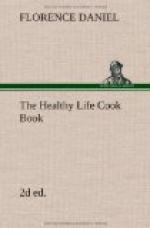Another method of mixing is the following:—Put the water into the basin first and stir the meal quickly into it with a spatula or wooden spoon. When it gets too stiff to be stirred, add the rest of the meal. Knead for two minutes, and shape into loaves as above.
BAKING.—Bake on the bare oven shelf, floored. If possible have a few holes bored in the shelf. This is not absolutely necessary, but any tinker or ironmonger will perforate your shelf for a few pence. Better still are wire shelves, like sieves. (This does not apply to gas ovens.)
Start with a hot oven, but not too hot. To test, sprinkle a teaspoonful of flour in a patty pan, and put in the oven for five minutes. At the end of that time, if the flour is a light golden-brown colour, the oven is right. Now put in the bread and keep the heat of the oven well up for half an hour. At the end of this time turn the loaves. Now bake for another hour, but do not make up the fire again. Let the oven get slightly cooler. The same result may perhaps be obtained by moving to a cooler shelf. It all depends on the oven. But always start with a hot oven, and after the first half hour let the oven get cooler.
Always remember, that the larger the loaves the slower must be the baking, otherwise they will be overdone on the outside and underdone in the middle.
Do not open the oven door oftener than absolutely necessary.
If a gas oven is used the bread must be baked on a baking sheet placed on a sand tin. A sand tin is the ordinary square or oblong baking tin, generally supplied with gas stoves, filled with silver sand. A baking sheet is simply a piece of sheet-iron, a size smaller than the oven shelves, so that the heat may pass up and round it. Any ironmonger will cut one to size for a few pence. Do not forget to place a vessel of water (hot) in the bottom of the oven. This is always necessary in a gas oven when baking bread, cakes or pastry.
It must not be forgotten that ovens are like children they need understanding. The temperature of the kitchen and the oven’s nearness to a window or door will often make a difference of five or ten minutes in the time needed for baking. One gas oven that I knew never baked well in winter unless a screen was put before it to keep away draughts!
ROLLS.—If you desire to get your bread more quickly it is only a question of making smaller loaves. Little rolls may be cut out with a large egg-cup or small pastry cutter, and these take any time from twenty minutes to half an hour.
2. EGG BREAD.
9 ozs. fine wholemeal, 1 egg, a bare 1/2 pint milk and water, butter size of walnut.
Put butter in a qr. qtn. tin (a small square-cornered tin price 6-1/2d. at most ironmongers) and let it remain in hot oven until it boils. Well whisk egg, and add to it the milk and water. Sift into this liquid the wholemeal, stirring all the time. Pour this batter into the hot buttered tin. Bake in a very hot oven for 50 minutes, then move to a cooler part for another 50 minutes. When done, turn out and stand on end to cool.




